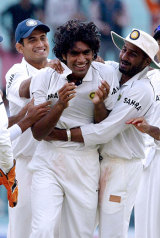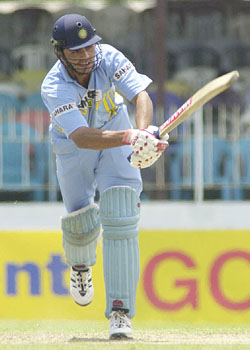Munaf embraces the hopes of a nation
'It's better to burn out than to fade away' might sound profound when you're listening to Neil Young, but it's the last thing you want from young cricketers with genuine potential
Dileep Premachandran
09-Mar-2006
|
|

|
The transient nature of sporting fame is best illustrated by one of the
portraits on the wall of the long room where the press conferences are
held in Mohali. It shows Reetinder Singh Sodhi holding aloft his award for
being the outstanding performer in the final of the Lombard Challenge
Under-15 Cup in 1996. Having picked up the wickets of Taufeeq Umar, Yasir
Arafat and Kamran Akmal - all three of whom would subsequently play for
the senior side - Sodhi then rattled off a composed 82 to lead his side to
a tense four-wicket victory against a team led by Faisal Iqbal.
Having starred for the Under-19s as well, it was no surprise when he was
pitchforked into the national side at the age of 20. Designated as the
allround hope, he failed miserably to live up to the advance billing, and
a stop-start one-day career encompassing 18 matches hit the skids after
280 runs at 25.45 and a paltry five wickets. Three years on from his last
appearance against the West Indies at Jodhpur, he isn't even a cursory
mention when the selectors discuss probables for the national side.
When England visited Mohali four years ago, an Indian side affected by
injuries and ill health gave three men their first caps. Two of them,
Sanjay Bangar and Iqbal Siddiqui, were seen as temporary solutions,
band-aids if you will, but the third arrived on the scene with much hype
and a vote of confidence from Dennis Lillee and the MRF Pace Foundation.
Tinu Yohannan had inherited his father's athleticism, and there were
certainly glimpses of promise in a first Test outing that realised innings
figures of 2 for 75 and 2 for 56. Mark Butcher, the hero of Headingley a
few months earlier, and Marcus Trescothick, both fell to him twice and his
ability to move the ball at lively pace impressed many that watched him.
|
|

|
Nobody would wish such a fate on Munaf Patel, and there were enough signs
on an abbreviated opening day to suggest that India's pace woes may at
least be partly solved by a man whose rise to the highest echelon has been
anything but smooth. Labelled a speed demon when he burst on the scene
three years ago, Munaf then had to battle injury and loss of form and
confidence - not to mention migration from Baroda to Mumbai, and thence to
Maharashtra - as his stock plummeted. Sandeep Patil's harsh assessment of
his mental fortitude in the aftermath of an A team tour did him no favours
either, and when a Maharashtra side coached by Darren Holder, an
Australian, took a punt on him before the start of the current domestic
season, it was seen as a massive gamble.
A couple of lethal spells in the Ranji Trophy pushed him back into the
limelight, but when England arrived in Baroda for a warm-up game, the
focus was very much on Vikram Raj Vir Singh, touted as the fastest bowler
in the land. But while he sprayed the ball around like a hyperactive kid
with a hose, it was Munaf, with a remodelled action, that took the
plaudits with 10 for 91. He mopped up the tail with ease on both
occasions, and bowled with a controlled menace that suggested his wild and
woolly ways were behind him,
That he has the ability to bowl genuinely quick has never been in doubt.
After a tentative start with the new ball today - he averaged in the
region of 82 mph - he got rid of the cotton wool and let rip in late
afternoon. The fourth ball of his 10th over was a reverse-swinging yorker
speared in at 89.9 mph, and Paul Collingwood was a relieved man to see it
roll past the stumps after he just about squeezed down on it.
Two balls later, he had his first wicket, courtesy of a lazy waft back from
Kevin Pietersen. He would bowl only eight more deliveries before bad light
forced the players off. In a sense, it was just as well. Indian cricket
has seen far too many over-trumpeted debuts that didn't amount to much,
and the last thing that the new and improved Munaf needs is for everyone
to hitch their wagons to his star.
"It's better to burn out than to fade away" might sound profound when you're listening to Neil Young, but it's the last thing you want from young cricketers with genuine potential. If you need a cautionary tale, just glance at that photograph of the fresh-faced Sodhi ... and a career that reached its pinnacle at 16.
Dileep Premachandran is features editor of Cricinfo